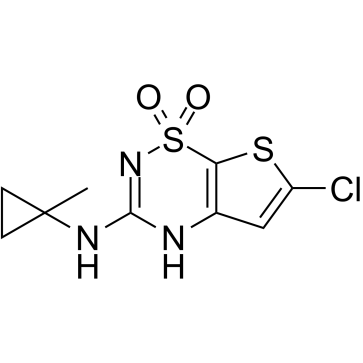| Description |
Tifenazoxide (NN414) is a potent, orally active and SUR1/Kir6.2 selective KATP channels opener. Tifenazoxide has antidiabetic effect, can inhibit glucose stimulated insulin release in vitro and in vivo, and has a beneficial effect on glucose homeostasis[1][2].
|
| Related Catalog |
|
| Target |
KATP channels[1][2]
|
| In Vitro |
Tifenazoxide (NN414) hyperpolarises βTC3 cell membranes, and inhibits insulin release from βTC6, from isolated rat islets and from human islets at least a 100-fold more potent than Diazoxide[2]. The EC50 values for Tifenazoxide and diazoxide are 0.45 and 31 µM, respectively in the patch-clamp assay. Tifenazoxide (100 µM) activates Kir6.2/SUR1 channels, but not Kir6.2/SUR2A or Kir6.2/SUR2 channels, expressed in Xenopus oocytes both in whole-cell and inside-out macropatch recordings[2]. Tifenazoxide is a potent inhibitor of glucose stimulated insulin release from βTC6 cells (IC50 = 0.15 µM)[1].
|
| In Vivo |
Tifenazoxide (NN414; 1.5 mg/kg; oral administration; twice daily; for 3 weeks; male VDF Zucker (fa/fa) rat) treatment for 3 weeks in VDF rats reduces basal hyperglycemia, improves glucose tolerance, and reduces hyperinsulinemia during an oral glucose tolerance test (OGTT) and improves insulin secretory responsiveness ex vivo[1]. Animal Model: Male Vancouver diabetic fatty (VDF) Zucker rat[1] Dosage: 1.5 mg/kg Administration: Oral administration; twice daily; for 3 weeks Result: Basal glucose was significantly reduced with the fall averaging 0.64 mM after 3 weeks of treatment.
|
| References |
[1]. Carr RD, et al. NN414, a SUR1/Kir6.2-selective potassium channel opener, reduces blood glucose and improves glucose tolerance in the VDF Zucker rat. Diabetes. 2003 Oct;52(10):2513-8. [2]. Hansen JB. Towards selective Kir6.2/SUR1 potassium channel openers, medicinal chemistry and therapeutic perspectives. Curr Med Chem. 2006;13(4):361-76.
|
